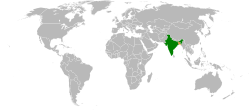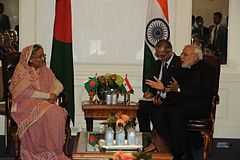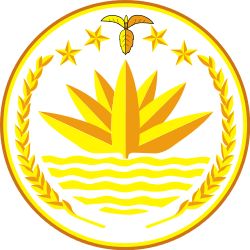Bangladesh–India relations
 |
|
India |
Bangladesh |
|---|---|

Bangladesh and India are part of South Asia. They are common members of SAARC, BIMSTEC, IORA and the Commonwealth. Bangladesh and the Indian states of West Bengal, Assam and Tripura share the Bengali language.
The two nations were strong allies during the Bangladesh Liberation War in 1971. However, they developed different Cold War alliances in the late 1970s and 80s.[1][2] With the onset of economic liberalization in South Asia, they forged greater engagement and trade. The historic Ganges Water Sharing Treaty was concluded in 1996. Bangladesh and India are close strategic partners in counter-terrorism. They are the largest trading partners in South Asia.[3] Two-way trade is estimated to be over US$7 billion. Bangladesh is also the fifth largest source for India's remittances, being home to a large Illegal Indian community.[4]
Indo-Bangladeshi ties remain strained due to issues with water sharing (as India has blocked rivers while simultaneously decrying China for doing so), ease of doing business and border security. The territories of both countries are prone to use by militant groups and insurgents. The Indian Border Security Force has indiscriminately killed unarmed Bangladeshi civilians; while Indian media and right-wing political parties accuse Bangladesh of promoting illegal immigration.
Foreign Minister Sushma Swaraj visited Bangladesh in her first official overseas trip in June, 2014.
Areas of contention
- A major area of contention has been the construction and operation of the Farakka Barrage by India to increase water supply in the river Hoogly. Bangladesh insists that it does not receive a fair share of the Ganges waters during the drier seasons, and gets flooded during the monsoons when India releases excess waters. See also Sharing of Ganges Waters.
- There have also been disputes regarding the transfer of Teen Bigha Corridor to Bangladesh. Part of Bangladesh is surrounded by the Indian state of West Bengal. On 26 June 1992, India leased three bigha land to Bangladesh to connect this enclave with mainland Bangladesh. There was a dispute regarding the indefinite nature of the lease. The dispute was resolved by an mutual agreement between India and Bangladesh in 2011.[5]
- Terrorist activities carried out by outfits based in both countries, like Banga Sena and Harkat-ul-Jihad-al-Islami.[6] Recently India and Bangladesh had agreed jointly to fight terrorism.[7]
- Bangladesh has consistently denied India transit facility to the landlocked North Eastern Regions of India. Although India has a narrow land link to this North eastern region, which is famously known as the Siliguri Corridor or "India's Chicken Neck"[8]
- Illegal Bangladeshi immigration into India.[9] The border is porous and migrants are able to cross illegally, though sometimes only in return for financial or other incentives to border security personnel.[9] Bangladeshi officials have denied the existence of Bangladeshis living in India and those illegal migrants found are described as having been trafficked.[9] This has considerable repercussions for those involved, as they are stigmatized for having been involved in prostitution, whether or not this has actually been the case. Cross border migrants are also at far higher risk of HIV/Aids infection.[9]
- Continuous border killing of Indian and Bangladeshi people, aiding illegal immigrants, helping in armed dacoity, fake money transfer and illegal drug trades by both Indian and Bangladeshi people are the major problems between Bangladesh and India.
- Both Bangladesh and India make claims over the same seawater at the Bay of Bengal.[10]
- There was a minor glitch in their relation when former Indian Prime Minister Manmohan Singh accidentally mentioned that 25% of Bangladeshis are anti-Indian, during an informal press meet.[11]
Border killings of Bangladeshi civilians
Deaths of Bangladeshi citizens in the Indo-Bangladesh border became one of the embarrassments between the two nation’s bilateral relations in recent years. The so-called ‘shoot-to-kill’ policy by the India’s Border Security Forces (BSF)[12] that according to Human Rights Watch killed nearly 1,000 Bangladeshis between 2001 and 2011 has remained at the core of the talks between Bangladeshi and Indian officials visiting each other.[13][14]
Indian officials visiting Bangladesh, including the Indian foreign ministers and BSF chiefs numerously vowed to stop BSF shootings, but Bangladeshi nationals, comprising both illicit border crossers and innocents, have continued to be shot dead by the Indian troops.[15]
While anger grew in Bangladesh because of the continued BSF shootings and subsequent deaths,[12][16][17] Indian officials argue that heightened security has followed the increasing flow of illegal migrations into India as well as continued misuse of the border by illicit traders. Indian officials, vowing to cut down the number of casualties at border, showed statistics that the number of Bangladeshi deaths was in a steady decline in recent years.[15]
The Bangladeshi deaths caused by BSF shootings at the border became subject to a so-called cyber war between the hackers of the two countries that took the websites of BSF, National Informatics Centre and Trinamool Congress as victims.[18] The government of Bangladesh was found to comment on the issue condemning the cyber attacks on Indian websites.
Recent developments
In September 2011, the two countries signed a major accord on border demarcation to end the 4-decade old disputes over boundaries.This came to be known as the tin bigha corridor. India also granted 24-hour access to Bangladeshi citizens in the Tin Bigha Corridor. The agreement included exchange of adversely held enclaves, involving 51,000 people spread over 111 Indian enclaves in Bangladesh and 51 Bangladesh enclaves in India. The total land involved is reportedly 7000 acres.[19]
On 9 October 2011, Indian and Bangladeshi armies participated in Sampriti-II (Unity-II), a 14-day-long Joint military exercise at Sylhet to increase synergy between their forces.[20]
In 2012, Bangladesh allowed India’s Oil and Natural Gas Corporation to ferry heavy machinery, turbines and cargo through Ashuganj for Palatana Power project in southern Tripura.[21]
From October 2013, India started exporting 500 megawatts of electricity a day to Bangladesh over a period of 35 years. A 125-kilometre Baharampur-Bheramara transmission line, 40 km of it in Bangladesh, connects the two substations. Bangladesh officials believe the export would greatly ease the national shortage once 500 MW flows into the national grid. The two country's Prime Ministers also unveiled the plaque of the 1,320-MW coal-fired Rampal power plant, a joint venture between the two countries.[22] The link is being seen as a major milestone in strengthening the bilateral relationship and comes at a time when India is desperate to make up for its inability to deliver on two key pacts with Bangladesh: one on Teesta waters and the land boundary pact.[23]
From November 2013, Wagah Border like ceremony is being organised at Petrapole (in West Bengal, India) - Benapole (Bangladesh) border checkpoint.The ceremony which includes parades, march-past and lowering of the national flag of both the countries is now a daily routine, at sundown, on the eastern border.[24] The relations between the countries are definitely moving in positive direction.
In June 2014, during her first official overseas visit, Foreign Minister of India, Sushma Swaraj concluded various agreements to boost ties. They include:
- Easing of Visa regime to provide 5 year multiple entry visas to minors below 13 and elderly above 65.
- Proposal of a special economic zone in Bangladesh.
- Agreement to send back a fugitive murder accused from India.
- Provide an additional 100 MW power from Tripura.
- Increase the frequency of Maitree Express and start buses between Dhaka and Guwahati and Shillong.
- Bangladesh allowed India to ferry foodgrains to the landlocked North East Indias using its territory and infrastructure.[21]
References
- ↑ https://books.google.com.bd/books?id=5lH40gT7xvYC&pg=PA31&dq=ziaur+rahman+foreign+policy&hl=en&sa=X&ei=rRKPVOWgHIOXuQTGjIHADQ&redir_esc=y
- ↑ https://books.google.com.bd/books?id=cVNRX5QRXTkC&pg=PA240&dq=ziaur+rahman+foreign+policy&hl=en&sa=X&ei=rRKPVOWgHIOXuQTGjIHADQ&redir_esc=y
- ↑ http://www.business-standard.com/article/government-press-release/trade-between-india-and-bangladesh-114121800028_1.html
- ↑ http://www.dhakatribune.com/long-form/2014/apr/01/modi-fying-bangladesh-india-relations
- ↑ Dholabhai, Nishit (2011-07-21). "24/7 access for Bangla via corridor". Calcutta, India: The Telegraph. Retrieved 2012-10-24.
- ↑ "Bangladeshi Immigrants Stoke Terror in India". Asia Sentinel. 2008-05-15. Retrieved 2012-10-24.
- ↑ "Delhi, Dhaka to strengthen border management". Chennai, India: The Hindu. 2008-09-01. Retrieved 2012-10-24.
- ↑ "No transit deal with India: Bangladesh". The Times Of India. 29 August 2011.
- ↑ 9.0 9.1 9.2 9.3 Fiona Samuels and Sanju Wagle 2011. Population mobility and HIV and AIDS: review of laws, policies and treaties between Bangladesh, Nepal and India. London: Overseas Development Institute
- ↑ "India, Bangladesh to discuss maritime dispute". Thaindian News. 2010-01-08. Retrieved 2012-10-24.
- ↑ "After gaffe, PM calls Sheikh Hasina, announces Bangladesh dates". The Hindustan Times. 2011-07-24. Retrieved 2012-10-24.
- ↑ 12.0 12.1 "India/Bangladesh: Indiscriminate Killings, Abuse by Border Officers". Human Rights Watch. December 9, 2010. Retrieved 2012-10-29.
- ↑ "India's shoot-to-kill policy on the Bangladesh border". Guardian. 23 January 2011. Retrieved 2012-10-29.
- ↑ "Khaleda Zia assures counter-terror co-operation to India". Yahoo News. 2012-10-29. Retrieved 2012-10-29.
- ↑ 15.0 15.1 "BSF promises to bring down border casualties to zero". The Hindu. October 1, 2012. Retrieved 2012-10-29.
- ↑ "Bangladeshi dies as BSF throws stones". The Daily Star (Bangladesh). July 25, 2011. Retrieved 2012-10-29.
- ↑ "WB: Video showing BSF torture surfaces". IBN Live's YouTube channel. January 18, 2012. Retrieved 2012-10-29.
- ↑ "Bangladesh group hacks BSF website to 'avenge border killings'". Times of India. February 15, 2012. Retrieved 2012-10-29
- ↑ Sougata Mukhopadhyay (2011-09-07). "India-Bangladesh sign pact on border demarcation". CNN-IBN. Retrieved 2011-09-07.
- ↑ "Bangladesh-India joint military exercise begins". Zee News. 2011-10-29. Retrieved 2012-10-24.
- ↑ 21.0 21.1 "Bangladesh allows transit of Foodgrain to Northeast Indian States". IANS. news.biharprabha.com. Retrieved 12 June 2014.
- ↑ Habib, Haroon (2013-10-06). "India begins power export to Bangladesh". The Hindu (Chennai, India).
- ↑ http://www.indianexpress.com/news/indiabangladesh-power-transmission-link-open/1178942/
- ↑ http://www.thehindubusinessline.com/news/wagahlike-retreat-ceremony-on-indiabangladesh-border/article5322459.ece
See also
- Indians in Bangladesh
- Foreign relations of Bangladesh
- Foreign relations of India
- Indo-Bangladeshi barrier
- Indo-Bangladesh border
- Tripura Division
| ||||||||||||||||||||||
| ||||||||||||||||||||||||||||||||||||||||||||||||||||||||||||||||||||||||
| ||||||||||||||||||||||||||||||||||||||||||||||||||||||||

